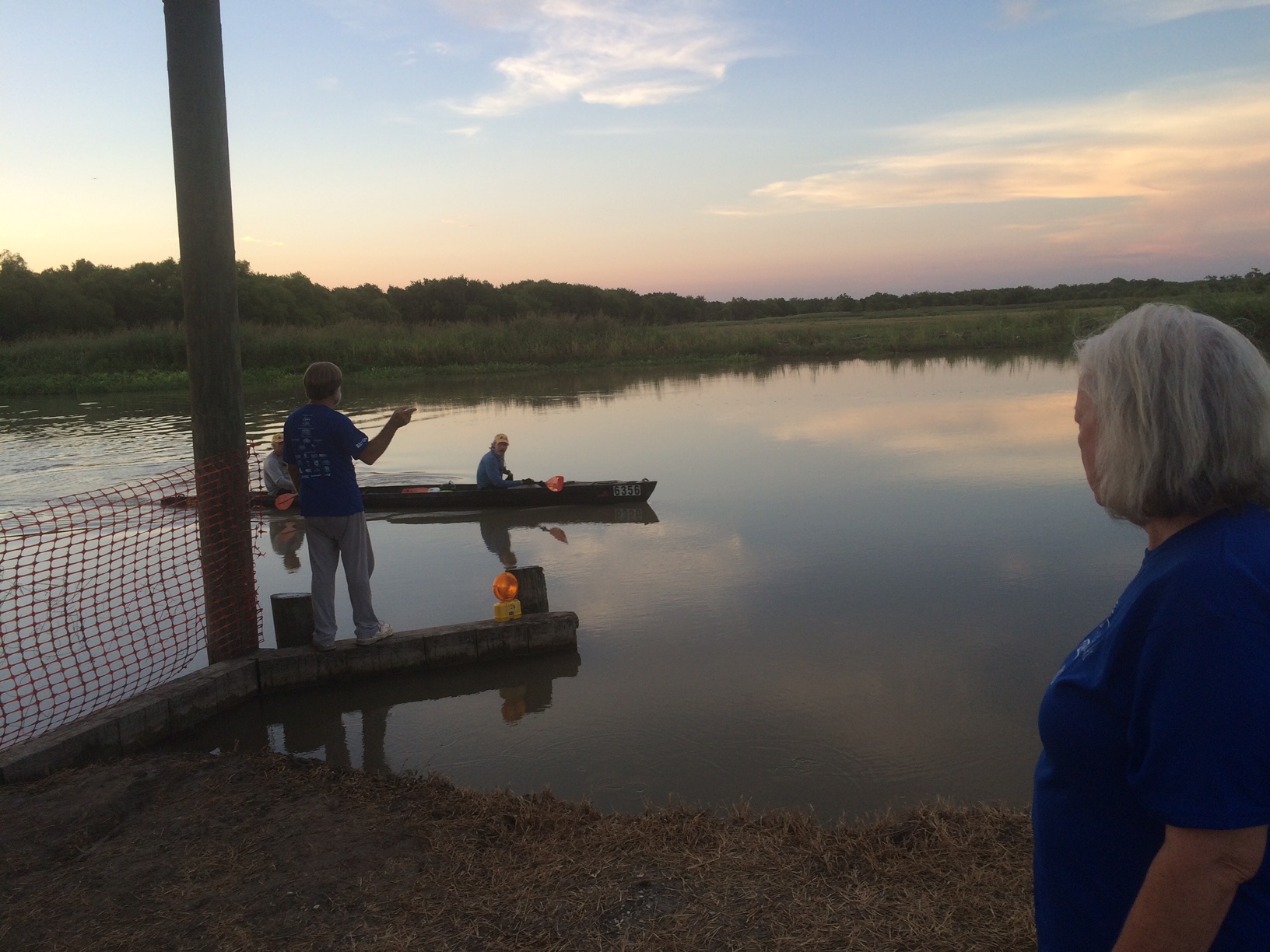Photo: Charles Clapsaddle directing racers to downstream check-in and portage.
Susie (wife), Carl (son), Tony Kouba (friend and fellow Canoe Trail Goliad enthusiast), and I spent Sunday through Wednesday manning on the behalf of Canoe Trail Goliad (http://www.canoetrailgoliad.com/) the final checkpoint on the Texas Water Safari (http://www.texaswatersafari.org/) canoe race, “The world’s TOUGHEST canoe race!”
Our checkpoint was the Saltwater Barrier on the Guadalupe River at mile 244 of the 260 mile race. The race starts at San Marcos at the headquarters of the San Marcos River, proceeds downstream to the Guadalupe River, and ends at Seadrift on the San Antonio Bay. Saltwater Barrier is named thusly because it is two neoprene bladders under the river that are periodically filled with water to create a barrier to saltwater intruding up the river. The barriers also maintain water levels so that water can flow into a canal providing water to Port Lavaca. When the bladders are inflated the checkpoint is a mandatory portage. This year, due to heavy rains, the bladders weren’t inflated, but a hazardous logjam caused a required portage. This portage, while short and not difficult, is despised by the racers who have been paddling day and night for 30 to 95 hours.
Our job, as race officials, was to check in and out the racers, insure compliance with race rules (fairly onerous, see the website for rules), and make sure the racers portaged instead of attempting to run the logjam. Many times, the racers (and their support teams) have been and are hallucinating from sleep deprivation. It can make for interesting interactions.
While many times the pace of boat arrivals is hectic there is some downtime (see photo below).

Left to right is Susie Clapsaddle, race official; Charles Clapsaddle, race official; and Larry Zermeno, Goliad County Auditor and friend. The dog, Maya, is one of our two German Shepherds that spent the four days at the checkpoint with us. The board behind us is where the team captains for the racers sign in and out. Due to the presence of alligators, we were very cautious with the dogs and didn’t allow them near the water in the dark.
The checkpoint is below one of the most difficult portions of the race, a section that offers the racers a myriad of choices at a time they aren’t always thinking clearly. Halfway from the prior checkpoint is a lake aptly named Alligator Lake. The lake isn’t on the river. It runs parallel to the river. There are several channels between the river and the lake. Racers often opt to exit the river and proceed down one of these channels into the lake in order to avoid the frequent, long logjams on the river, which require lengthy and arduous portages. Remember, at this point the racers have been on the river for more than 24 hours and some for three days. The lake, however, is not without its own hazards and some racers become lost in the lake necessitating rescue efforts.
We keep track of each boat through a tracking device mounted on each. The tracker updates usually every 10 minutes by sending a signal to a satellite. I say “usually” because if the tracker becomes miss-positioned, is under a tree, runs short of battery life, or is lost, then the signal doesn’t work. We can trace where boats have been through a website that reports the tracker positions as they signal the satellite. We can tell when a boat is lost in the lake because the website shows a history that looks like an effort of a young child to draw a star. This year that happened to several of the boats entering the lake.
Boats are also equipped with a cellphone in a sealed bag to be used for emergencies only. Use of the cellphone ends the race for that boat. There is also a panic button on the tracker. Its use also ends the race for that boat.
This year one boat quit sending updates 11:40 PM Sunday. By late morning Monday the rescue team was sent to find them. The rescue team planned to enter the river above the last reported position and search from that position downstream to our checkpoint. Shortly after the rescue team departed the missing boat arrived at the checkpoint. Their canoe had sunk about time of the last tracker update. They spent the night in mud and water and at dawn searched using sticks to find their canoe underwater and stuck in mud. They righted the canoe and proceeded on. The tracker didn’t survive. At our checkpoint they were equipped with another tracker and they went on to finish the race.
On Monday, around noon, another boat ceased sending updates on one of the channels leading to Alligator Lake. This boat had two women aged 52 and 61. We anxiously watched for tracker updates to no avail. Each boat coming through the checkpoint was interrogated to see if they had seen the women. No one had; however, none had gone through Alligator Lake, all had opted to portage on the river.
When the remaining two boats in the race arrived at our checkpoint we discovered they hadn’t seen the women. Both boats had entered Alligator Lake, gotten lost, and returned to the river to finish. A rescue team in a canoe paddled up river, through the lake, and finally found them thirsty and mosquito bitten near the site of last tracker update. The women were given water and brought to Saltwater Barrier. They had swamped and their canoe ended up about a quarter mile downstream. All communication devices went with the canoe.
Having no canoe and having missed the 8:00 AM Wednesday deadline for reaching the Saltwater Barrier checkpoint, they were disqualified. It’s not billed as “The world’s TOUGHEST canoe race!” for nothing.


Leave a Reply